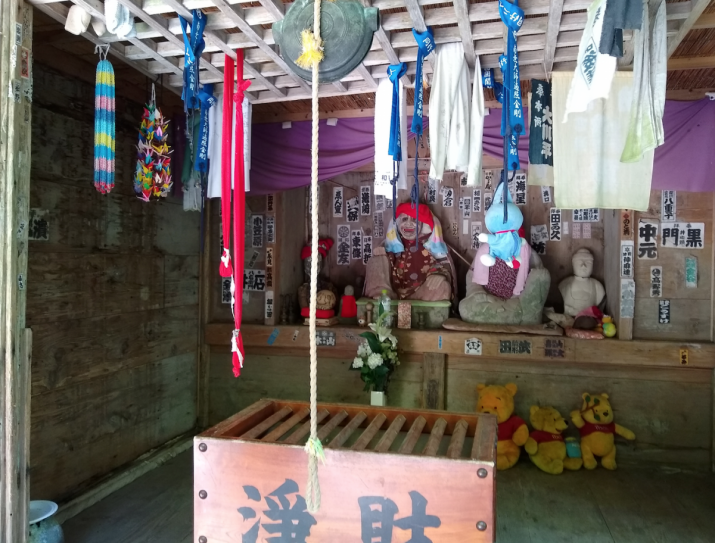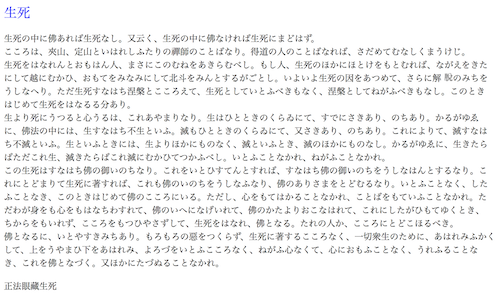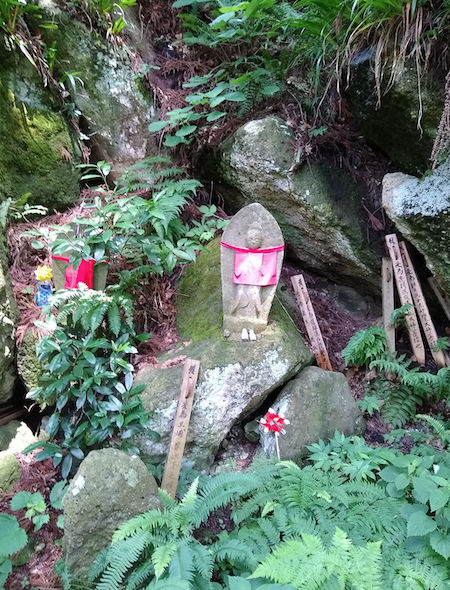FEATURES|COLUMNS|Buddhism in Japan
Death and Dying in Japanese Buddhism
 Remembering the dead on Yamadera. Image courtesy of the author
Remembering the dead on Yamadera. Image courtesy of the authorIn two of my earlier essays for this column, I discussed death rites* and conceptions of death** in Japanese Buddhism. I was recently invited to the Isehara campus of Tōkai University to talk to students and professors of the faculty of nursing about these conceptions of death in Japanese religions. This was, of course, an interesting scenario, a philosopher of religion talking to present and future healthcare professionals about death. The discussions we had after my talk and during the reception in the evening were extremely engaging and inspired this article.
During the reception after the talk, one of the professors asked me about Buddhist—particularly Dōgen’s—approaches to euthanasia. This question is, of course, enormously difficult since a) there is no one Buddhist conception of death and moral behavior, and b) this particular moral dilemma was certainly alien to Dōgen. But I would like to reflect here on how one can think about the moral dilemmas surrounding aging, death care, and death using concepts and theoretical frameworks provided by Buddhist thinkers and texts in Japan.
The question of how Buddhist thinkers, institutions, and texts in Japan respond to contemporary issues regarding death is interesting for four reasons. First, in Japan, Buddhism has been always associated with death rituals since the danka edict of 1638 required all citizens to affiliate with a local Buddhist temple via the family grave. This affiliation of families with Buddhist temples became so ingrained in the religious and social infrastructure of Japan that it remained the predominant feature of Buddhism in Japan, even after the reversal of this edict in the early Meiji period (1868–1912), and led to the curious phrase “funeral Buddhism” (Jap: sōshiki bukkyō), which has become one of the principal descriptors of Buddhism in Japan. The anthropologist Ian Reader famously coined the phrase that, in Japan, people are “born Shintō” (Reader 1991, 55) and “die Buddhist” (ibid. 77). Second, from its very conception Buddhist teaching and practice focused on the alleviation of suffering (Skt: duḥkha), identified by the first three of the four sights the young Buddha saw as sickness, old age, and death. Third, in recent years, Buddhist institutions in Japan have found themselves at a watershed moment as they are confronted with an aging population as well as an ever-diminishing identification of especially young people with the Buddhist institutions, beliefs, and practices. This phenomenon is commonly called “flight from Buddhist temples” (Jap. terabanare). Finally, the devastation brought to Japan by the 11 March 2011 tsunami has affected most people in Japan deeply, prompting many Japanese to search for meaning and to grapple anew with the age-old Zen question regarding the “great matter of life and death” (Jap: shōji daiji).

Dōgen’s “Shōji.” From shomonji.or.jp
These four factors combine to a unique situation that provides simultaneously a significant challenge and exciting opportunities for Buddhist individuals and institutions in Japan. It has also inspired quite a few Buddhists in Japan to explore innovative ways of being Buddhist in the contemporary world. As I wrote in an earlier essay,*** Ven. Nemoto Ittetsu in Tokyo runs a suicide-prevention program out of his temple Daizen-ji; Ven. Alubomulle Sumanasara, a Sri Lankan monk who is now head priest of Asugiriya-dai-ji and the chief advisor of the Theravāda Buddhist Association in Japan, has written on Buddhist counseling in the case of bullying and suicide; Minami Jikisai, head priest of Reisen-ji who served temporarily at Bodai-ji on Mt. Osore,* is a prolific writer on topics related to “birth and death” (Jap: shōji), encountering the dead, and facing death in a meaningful way. The books of Sumanasara and Minami are aimed at and reach a rather large audience. Prof. Carl Becker (Kyoto University) has told me about cutting-edge new programs such as the Department of Death and Life Studies at Sophia University (that started in 2007 at Tokyo University before it moved to its current location) and the program in “clinical religious studies” (Jap: rinshō shūkyōgaku) at Tōhoku University, which constitutes the first Buddhist chaplaincy program in Japan. Finally, professors Suzuki Iwayumi and Satō Hiro’o have conducted trailblazing ethnographic studies of death rituals and care in Japan. This is a growing field that provides many exciting opportunities for practitioners to enact and apply the teaching of the Buddha in the contemporary world.
Having set the context of death rituals and death care in contemporary Japan, I would like to return to the question I was asked after my talk on Buddhist conceptions of death last week: What would Dōgen say about euthanasia and similar moral dilemmas regarding death care. As I indicated above, I will not attempt to put words into the mouth of a 13th century Zen master to solve a contemporary quandary, but I can apply traditional Buddhist conceptions to possibly illuminate a serious and pressing issue.

Some of the books mentioned in the article. Image courtesy of the author
Since Buddhism is a diverse tradition, there is not one position on any metaphysical or ethical question, so I will try to engage a variety of possible answers. A first response to the question would be based on the five precepts. The first precept very clearly prohibits any form of injury and thus can be read to directly discourage the practice of euthanasia. Such a prohibition would be supported by the general law of karma, which indicates that every action, speech, and word directly effects our life in the future as well as our future lives. On the other hand, Mahāyāna texts such as the Vimalakīrti-nirdeśa-sūtra suggest that bodhisattvas sometimes break the precepts in order to alleviate suffering. According to this way of thinking, compassion overrides adherence to the precepts. Dōgen makes things even more complicated by suggesting that “adherence to the precepts by the voice hearers is no different from the violation of the precepts by the bodhisattva,” (DZZ 1: 280)**** suggesting that our actions need to be “expressions” (Jap: dōtoku) of compassion, the buddha-way, and, ultimately, the bodhisattva vow to “liberate all sentient beings.”
How this rather abstract principle translates into a concrete morality, then, depends on the situation and may not be able to be framed in a universally applicable principle. To Dōgen, buddhahood is to be found in every moment in a unique and lucidly manifest manner. These moments, Dōgen insists, express buddhahood fully but not completely. Dōgen said with regard to our topic today, “life exists in one moment; there is already [what came] ‘before’ and there is also [what will come] ‘after.’ For this reason, in the Buddhadharma, there is life and no-life. Destruction exists in one moment; because of that, there is destruction and there is no-destruction. . . . In this life-and-death, the very life of buddhas arises.” (DZZ 1: 778).

Remembering the dead on Yamadera. Image courtesy of the author
* How to Face Death – Pilgrimages and Death rituals in Japanese Buddhism (Buddhistdoor Global)
** Who will we be: Japanese Buddhist Conceptions of the Afterlife (Buddhistdoor Global)
*** Meaning in the Face of Transience: Reflections of Socially Engaged Buddhists in Japan (Buddhistdoor Global)
**** What use is Morality for Meditation (Buddhistdoor Global)
References
DZZ. Dōgen zenji zenshū [Complete Works of Zen Master Dōgen]. Two volumes, ed. Dōshū Ōkubo. Tokyo: Chikuma Shobō, 1969–70.
Reader, Ian. 1991. Religion in Contemporary Japan. Honolulu: University of Hawaii Press.
Related features from Buddhistdoor Global
Midwifing Death with Love – Applied Buddhism for Animal Care
Tibetan Book of the Dead, Part One: Cosmic Jumper
Tibetan Book of the Dead, Part Two: The Hour of Our Death
Tibetan Book of the Dead, Part Three: One Last Dance














